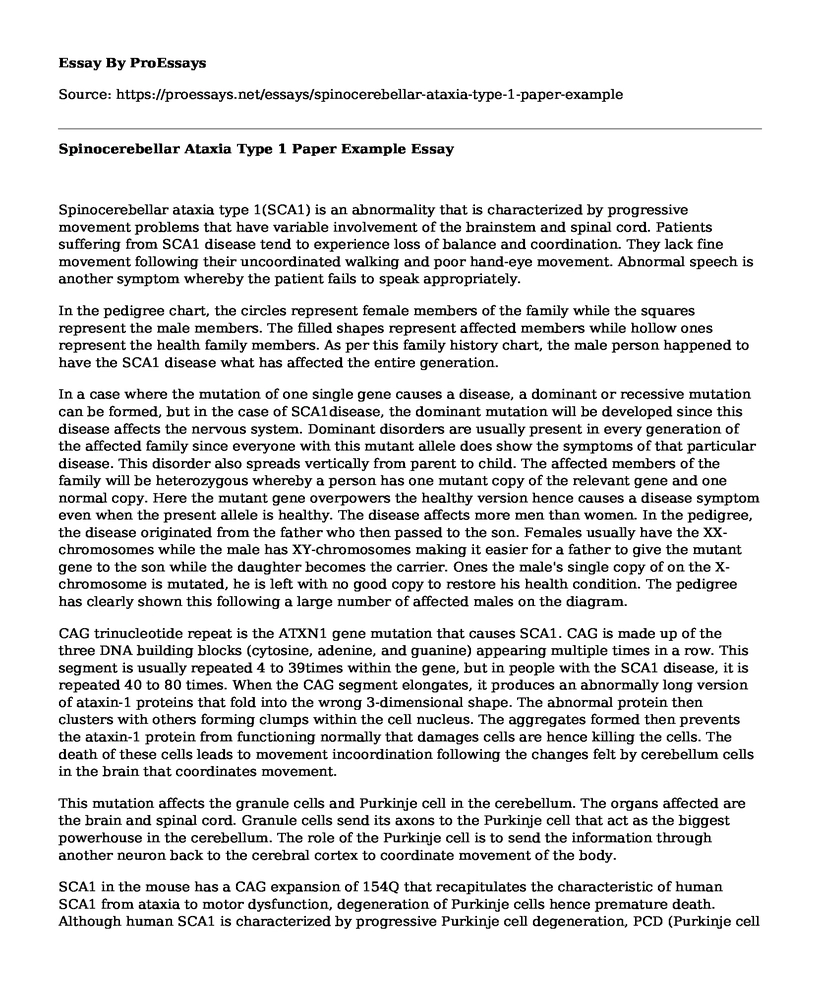Spinocerebellar ataxia type 1(SCA1) is an abnormality that is characterized by progressive movement problems that have variable involvement of the brainstem and spinal cord. Patients suffering from SCA1 disease tend to experience loss of balance and coordination. They lack fine movement following their uncoordinated walking and poor hand-eye movement. Abnormal speech is another symptom whereby the patient fails to speak appropriately.
In the pedigree chart, the circles represent female members of the family while the squares represent the male members. The filled shapes represent affected members while hollow ones represent the health family members. As per this family history chart, the male person happened to have the SCA1 disease what has affected the entire generation.
In a case where the mutation of one single gene causes a disease, a dominant or recessive mutation can be formed, but in the case of SCA1disease, the dominant mutation will be developed since this disease affects the nervous system. Dominant disorders are usually present in every generation of the affected family since everyone with this mutant allele does show the symptoms of that particular disease. This disorder also spreads vertically from parent to child. The affected members of the family will be heterozygous whereby a person has one mutant copy of the relevant gene and one normal copy. Here the mutant gene overpowers the healthy version hence causes a disease symptom even when the present allele is healthy. The disease affects more men than women. In the pedigree, the disease originated from the father who then passed to the son. Females usually have the XX-chromosomes while the male has XY-chromosomes making it easier for a father to give the mutant gene to the son while the daughter becomes the carrier. Ones the male's single copy of on the X-chromosome is mutated, he is left with no good copy to restore his health condition. The pedigree has clearly shown this following a large number of affected males on the diagram.
CAG trinucleotide repeat is the ATXN1 gene mutation that causes SCA1. CAG is made up of the three DNA building blocks (cytosine, adenine, and guanine) appearing multiple times in a row. This segment is usually repeated 4 to 39times within the gene, but in people with the SCA1 disease, it is repeated 40 to 80 times. When the CAG segment elongates, it produces an abnormally long version of ataxin-1 proteins that fold into the wrong 3-dimensional shape. The abnormal protein then clusters with others forming clumps within the cell nucleus. The aggregates formed then prevents the ataxin-1 protein from functioning normally that damages cells are hence killing the cells. The death of these cells leads to movement incoordination following the changes felt by cerebellum cells in the brain that coordinates movement.
This mutation affects the granule cells and Purkinje cell in the cerebellum. The organs affected are the brain and spinal cord. Granule cells send its axons to the Purkinje cell that act as the biggest powerhouse in the cerebellum. The role of the Purkinje cell is to send the information through another neuron back to the cerebral cortex to coordinate movement of the body.
SCA1 in the mouse has a CAG expansion of 154Q that recapitulates the characteristic of human SCA1 from ataxia to motor dysfunction, degeneration of Purkinje cells hence premature death. Although human SCA1 is characterized by progressive Purkinje cell degeneration, PCD (Purkinje cell degeneration) mutation in the mouse is not caused by a mutation in the murine Sca1 gene since linkage studies indicated that 7 or more chromosomes separate the two loci. Symptoms observed in the SCA1 mouse present the same results from the symptoms of patients suffering from the SCA1 disease.
The loss of function of protein does not cause SCA1. This disease is usually caused by the expansion of a CAG trinucleotide repeat encoding a polyglutamine tract. CAG encodes amino acid glutamine forming multiple of them hence the formation of polyglutamine. Polyglutamine disorder causes many diseases with SCA1 being one of them. Again-of- function mutation makes the protein to interact with different new proteins that it usually does not interact with causing SCA1 disease.
Drosophila has a short life cycle compared to that of a mouse what allows production of large quantities of flies within a short period. One female fly can produce 1500 eggs within a lifetime hence the constant supply of new Drosophila for the study. Genetic manipulation of Drosophila also makes it an ideal model organism. It has only four pairs of chromosomes, and that makes its genes easily mapped for investigating genetic transmission. Drosophila has one tau gene that is expressed in neurons and localized in axonal processes what makes it a suitable model.
Conclusion
Protein kinase AKT was found to be implicated in the SCA1 when they used the Drosophila model. AKT being an enzyme, the researchers can now see some kinase inhibitors and hopefully develop pill since inhibitors can come in the form of a medicine or a tablet. The tablets can then be tested on the mice before being used on a human being for treatment.
Cite this page
Spinocerebellar Ataxia Type 1 Paper Example. (2022, Sep 11). Retrieved from https://proessays.net/essays/spinocerebellar-ataxia-type-1-paper-example
If you are the original author of this essay and no longer wish to have it published on the ProEssays website, please click below to request its removal:
- Review of Action Potential in the Heart
- Public Health Essay Example: Importance of Infection Control and Prevention
- Essay Sample on Advanced Nursing: Childhood Insomnia
- Essay Example on Person-Centered Care: Enhancing Health Care Performance
- Essay Sample on Nurse Uniforms: Hygiene & Professionalism for Healthcare Staffs
- COVID-19: A Deadly Respiratory Disease Spreading Fast - Essay Sample
- Suicide Rates - Report Example







